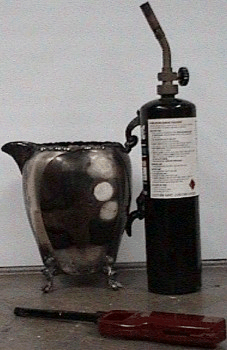Silver metal will oxidize spontaneously upon exposure to free oxygen. This process is commonly referred to as "tarnishing". The chemical reaction describing this proces is shown below.
4 Ag (s) + O2 (g) ® 2 Ag2O (s)
Silver metal is a grayish white color, silver oxide is a black color. This contrast in colors makes tarnished silver appear much different in appearence than untarnished silver. This explains why so much physical and chemical effort is spent in removing the tarnish from silver objects.
Thermodynamic Constants of Compounds of Interest [1]
| Compound | DHof (kJ/mol) | DGof (kJ/mol) | So (J/mol.K) |
|---|
| Ag (s) | 0 | 0 | 42.6 |
| O2 (g) |
0 | 0 | 205.2 |
| Ag2O (s) |
-31.1 | -11.2 | 121.3 |
The standard state enthalpy ( DHorxn) and entropy ( DSorxn) changes for the reaction are -62.2 kJ and -0.133 kJ/K respectively as calculated from the thermodynamic data in the above table. These values tell us that the reaction is exothermic and that the entropy of the reaction is negative. The decrease in entropy is to be expected when there are fewer moles of gaseous products than there were moles of gaseous reactants. The entropy and enthalpy terms are in conflict. The enthalpy term favors the reaction being spontaneous, but the entropy term favors the reaction being non-spontaneous. When the terms conflict in such a manner, the temperature at which the reaction occurs will determine the spontaneity. The following equation will allow the standard Gibb's free energy ( DGorxn) of the reaction to be calculated.
DGorxn = DHorxn - T DSorxn Eq. 1
Substituting the previously calculated values for the standard state enthalpy and entropy changes and the standard state temperature of 298 K into the previous equation yields:
DGorxn = -62.2 kJ - (298 K)(-0.133 kJ/K)
DGorxn = -22.6 kJ
Since DGorxn< 0, the reaction is spontaneous at room temperature. This agrees with our experience that silver does spontaneously tarnish as it sits in air. By rearranging Eq. 1 we may determine at what temperature the reaction would be at equilibrium ( DGorxn = 0). NOTE: It is not entirely accurate to use standard state thermodynamic quantities away from T = 298 K, since they do have a temperature dependence to them, but this usually introduces an acceptably small error in the resulting calculations.
T = DHorxn/ DSorxn
T = (-62.2 kJ)/(-0.133 kJ/K)
T = 468 K
For T < 468 K the reaction is spontaneous, for T = 468 K the reaction is at equilibrium and for T > 468 K the reaction would be non-spontaneous (or the reverse reaction, see reaction below, would be spontaneous). In order to remove the tarnish from our silver object all we need do is raise the temperature to above 468 K. The animated GIF below shows the temperature being raised by applying a propane torch's flame to the side of a badly tarnished silver pitcher.
2 Ag2O (s) ® 4 Ag (s) + O2 (g)
